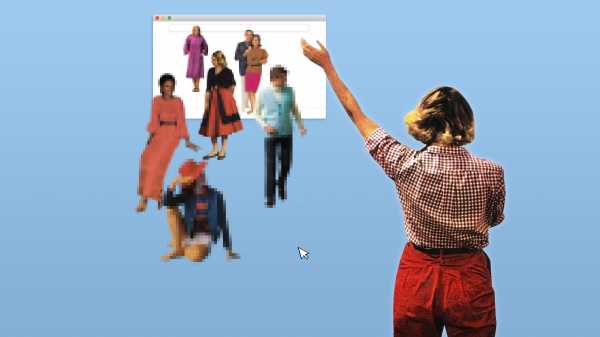
The stark loneliness of digital togetherness
Zoom, FaceTime, and other video calls have become the sole way for some friends and family to connect during quarantine. But does it really bring us closer, or only highlight the distance?
By
Laura Entis
May 26, 2020, 2:30pm EDT
Share this story
-
Share this on Facebook
-
Share this on Twitter
-
Share
All sharing options
Share
All sharing options for:
The stark loneliness of digital togetherness
-
Reddit
-
Pocket
-
Flipboard
-
Email
This story is part of a group of stories called

The wedding Hayden Dawes and his husband, Nick, envisioned was very different from the wedding they had. Members of a local Quaker community, the couple had planned a 100-person April ceremony that honored “what’s present and alive.” They’d pictured a reception full of hugs, singing, and dancing.
As their wedding date approached and the Covid-19 pandemic intensified, it became clear their plans would have to change. When the couple tied the knot in their backyard in Durham, North Carolina, last month, just three guests were in attendance, while a select group of family and close friends watched online. Their dream reception, in both size and atmosphere, didn’t seem possible through a grid of faces on Zoom. “It would have felt like a show to me,” Dawes says, adding an impersonal layer to a moment that was meant to be warm and joyous.
Deciding whether to use video platforms such as Zoom, Skype, or FaceTime to re-create in-person experiences has become a new facet of life under global social distancing rules. Of all the technologies we have at our disposal, these tools come the closest to replicating physical connection. “[They] help us understand and share emotions beyond just the words,” says Douglas Nemecek, the senior medical director for behavioral health at Cigna, which for the past few years has conducted an annual nationwide survey on loneliness.
Yet some, like Dawes and his husband, are finding that despite the miracle of being able to pull up loved ones’ faces on a screen, there’s something lacking — even painful — about digital togetherness. It’s a feeling rooted in dissonance, says Gianpiero Petriglieri, a trained psychiatrist and an associate professor of organizational behavior at Insead. “Every time you connect to a Zoom call, you are having two experiences at the same time: the experience of reaching, and the experience of what you’ve lost.”
Relying only on remote check-ins has left many people feeling adrift. For those already susceptible to loneliness, it can amplify existing feelings of isolation. Loneliness isn’t exclusively tied to being alone, of course — many people are happy in solitude — but the two are correlated. And while keeping social connections alive through Zoom happy hours and Skype birthday parties can help, they can’t fully substitute for the comfort we take in the physical presence of others, says James Coan, a psychology professor at the University of Virginia.
As our new, socially distant reality extends into its third month, this dissonance is coming to the fore. Three months ago, Polina Marinova, 28, a freelance writer, didn’t consider herself a lonely person. By virtue of living in New York City, she had access to continual social interactions even when moving through the urban crush alone. But since New York went into lockdown in March, she’s begun to feel a creeping sense of social isolation despite — and sometimes because of — a schedule packed with video calls.
Take, for example, a recent Friday, when Marinova and her fiancé played a board game with friends over Zoom. “It actually worked pretty well,” she says. After they hung up, however, she felt sad. “We’re playing, but it’s a continuous reminder — hey, we aren’t going to be able to do this in person for a very long time.”
Often, the experience of seeing friends and family over Zoom both relieves the ache we feel for the presence of others and sharpens it. There they are, peering at us through the screen; we can watch them laugh, take a sip of water, roll their eyes. It’s almost as if we’re with them; for a second or two, it’s possible to forget we’re not, until something inevitably shatters the illusion.
“It’s bittersweet. … It’s one half-step away,” says Scott Debb, an associate psychology professor at Norfolk State University. “It leaves you wanting a little bit more.” This can be particularly true for difficult conversations.
Petriglieri, 47, FaceTimes with his mother, who is in her late 80s and lives in Sicily, every day. Earlier in the pandemic, when Covid-19 cases were exploding in other parts of Italy, they discussed the possibility that they would not meet again. It was an important, necessary conversation. And yet, “I was having a conference call with my mother about her own mortality,” Petriglieri says. “It’s a lot more [emotionally] costly for her to say it, for us to talk about it, and then to have to press ‘leave meeting.’”
Video call fatigue is well-documented. Patty Brahe, 46, a substitute teacher sheltering in place with her husband and two kids in Beach Haven, New Jersey, regularly FaceTimes with her parents but says, “It’s awkward. They’re always freezing.”
Such glitches are common and disorienting. “I’m someone who relies heavily on facial cues and body language, so it’s hard to look at a grid of multiple people and try to decode their feelings or reactions,” says Marinova. “It’s especially bad when you tell a joke and no one reacts because there’s a delay. You are just sitting there kind of paralyzed with anxiety.” Meanwhile, the person who’s frozen — should their wifi ever kick in again — is unceremoniously deposited back into a conversation that has already moved on without them.
“You are having two experiences at the same time: the experience of reaching, and the experience of what you’ve lost”
Despite the apparent ability of video calls to re-create face-to-face conversation, our brains have to work to translate what we’re seeing. “We are dealing with an associative learning task,” Coan says. The person in front of us may look and sound like our mom, our partner, or our boss, but they’re also just pixels. The disconnect is subtle but continuous, an extra step in the communication process that, in the beginning, doesn’t feel so taxing. But as the video calls pile up, the gulf between the ease of face-to-face conversation and the more stilted process of interpreting facial cues and body language through a screen intensifies. “Slowly but surely, it starts to deliver diminishing returns,” Coan says.
Large hangouts can be particularly challenging. Before the coronavirus, video platforms such as Zoom and Webex were primarily used for teleconferences. Built as business services, video calls aren’t designed to handle the way we talk in informal groups, the way smaller conversations seamlessly splinter off and converge back with the main thread. On a screen with a grid of people all trying to maintain a single conversation, not cutting someone off requires vigilance. “It’s easier to just sit there and let everyone else talk,” Marinova says. “You don’t want to be the one who interrupts.”
Before the pandemic, Isaiah Headen, 36, a filmmaker and photographer in Washington, DC, would meet a group of close friends at a bar every few weeks. The gathering has moved to Zoom, with mixed results. “We’re all making time for it, but everyone is distracted while being together.” The sessions are a good way to catch up, but he says he misses the physical camaraderie that comes with sharing a space and the friendly ritual of buying rounds of drinks. “It’s much tighter-knit,” he says. “The conversation is deeper, whereas on the Zoom call, because we are all spread out, it’s much more surface-level.”
That’s another element that doesn’t translate so well over screens: silence.
While we often think of relationships as exchanges, Petriglieri sees them as spaces. Some of these spaces, shared with a manager, perhaps, or an in-law, are contained to specific contexts, in which silence is a discomfort to be papered over with logistics or small talk. Others are deeper and more expansive, giving us room to be nuanced, multifaceted versions of ourselves. “There are people you can be close to without having to say anything,” Petriglieri says. “I find the more intimate you become, the more silences are tolerable and potentially enjoyable.”
In person, at least. Through screens, staring into someone’s eyes or just sitting in companionable quiet is a high-wire act. Even the most innocuous pauses can become a source of anxiety. “Every time there is silence, it’s like, “‘Have you frozen?’” Petriglieri says.
But the biggest discrepancy between video and real life is, of course, touch. While screens can approximate face-to-face conversations, they can’t deliver even the faintest glimmer of physical contact. Dawes, who is a therapist, often asks if clients have mourned the loss of hugs.
It’s an important question. Touch is powerful; our need for it is primordial. Whereas most species evolved to survive in specific ecological environments, humans adapted to survive in groups. “We are each other’s habitat,” says Coan, whose lab at the University of Virginia studies the neural mechanisms in the brain that link social relationships to health and well-being.
A central focus of his research: hand-holding. “It turns out that hand-holding reveals a lot about how humans are, how we evolved, and how our brains work,” Coan says.
In a series of experiments conducted over the past 16 years, Coan put participants under threat of mild electric shock, either alone or while holding the hand of someone they knew and trusted. Typically, when we’re under stress, blood, and the glucose and oxygen within, flows to the prefrontal cortex, the region of the brain associated with threat vigilance and emotion regulation. This was true for participants who were alone — but not for those holding hands with someone they were close with.
This discrepancy goes a long way toward explaining why touch is so important, particularly for warding off loneliness. In order to relax, the brain needs to know that it has backup — that someone else is there to help should the need arise. Physical contact is the simplest, most powerful way of communicating that. “There’s nothing more concrete,” Coan says.
The absence of touch is a loss many people are feeling deeply right now, as is the sense of community we get simply from moving through a large crowd of people. Brahe longs to hug friends and family but also finds herself returning to an afternoon in New York City, shortly before lockdown, in which the sky suddenly opened. Waiting for the light to turn, she was stuck without an umbrella. The woman next to her had one, and moved close enough so it covered both of them — a spontaneous, warm gesture. Brahe misses these moments, and, by extension, the mundane activities such as subway rides and errands that pushed her against a rush of other people. No matter how many people are on a Zoom call, it just isn’t the same.
Even before the crisis, Americans were feeling increasingly socially isolated. According to a 2019 nationwide survey by Cigna, three out of five Americans said they are lonely, a 7 percent increase from just a year earlier.
Loneliness, or the perceived gap between the relationships we want and the ones we believe we have, manifests itself in a variety of ways. Young people who leave home for college, for example, are often momentarily lonely. Although the state is unpleasant, it’s a natural “pinch-point of experience,” says Fay Bound Alberti, a historian and the author of A Biography of Loneliness. “They are working out who they are.” Like physical pain or hunger, loneliness is a cue that alerts us to pay attention.
The danger lies with chronic loneliness. When we are alone for long periods but crave connection, our body becomes hypervigilant to social threats, both real and perceived. Over time, loneliness creates a self-reinforcing loop that causes us to see rejection and insult everywhere, making connection even more difficult.
Physically, chronic loneliness leads to a process called weathering, in which resources that power the immune system are diverted to the bloodstream and large muscles in order to prepare for danger. The body “stops growing hair, it stops repairing tissue, it stops fighting off infection effectively,” Coan says. This is why loneliness is often referred to as an “epidemic.” In a 2015 meta-analysis of 3 million people, which controlled for confounding factors such as demographics and objective isolation, loneliness increased odds of an early death by 26 percent.
While video calls help us stay connected, they’re missing many of the nonverbal components and cues that form the basis of our most intimate relationships. “So much of that information is lost,” Coan says.
There isn’t data yet on how the pandemic has affected loneliness levels on a broad scale, but Cigna’s Nemecek believes social distancing will have an impact long after the acute medical crisis has passed. “We are definitely seeing more anxiety, more stress, more isolation as we are all forced to shelter at home,” he says.
Like pretty much everything else in a capitalist society, the disruptions we’re experiencing are not equal-opportunity offenders. Long-term financial insecurity leads to “much tighter social connections. Individualism is something you need to be able to afford,” Petriglieri says. The fewer available resources to you, “the more likely you [are to] depend on social connections to survive.” The tragic paradox of the crisis is that we are in a situation in which we want (and, in some cases, need) our social networks more than ever, but the nature of the threat means that we must remain physically cut off from them.
Compounding this inequity: Many people can’t access videoconference technology at all. “If you relied on the public library to use their wifi but the library is closed, what do you do? If you don’t have a residence where your name is attached to a lease or a mortgage, how do you get service? It’s another example of the divide that exists in our society,” Debb, the psychology professor at Norfolk State University, says. “There are large numbers of people who don’t have the same access. We take for granted other people’s lived experiences.”
While any technology substituting for in-person connection will inevitably fall short, gratitude for what we do have and can control goes a long way. Dawes has found catharsis in quarantine. “My therapist and I talk about [the current situation] being a sifter,” one that reveals “what is really important and what can be left alone,” he says. For Dawes and his husband, having their close friends and family at their wedding was the most important thing — even if it was over Zoom.
Laura Entis is a writer and editor focusing on health, business, and science. Her work has appeared in Fortune, Fast Company, Time Health, GQ, Consumer Reports, and Outside Magazine. She previously covered the monetization of human connection for Vox’s The Highlight.
Sourse: vox.com





